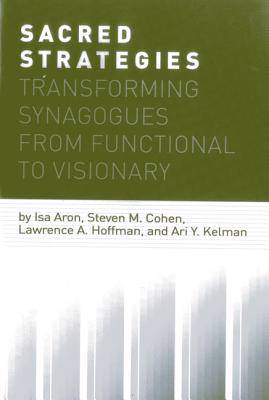
- Afhalen na 1 uur in een winkel met voorraad
- Gratis thuislevering in België vanaf € 30
- Ruim aanbod met 7 miljoen producten
- Afhalen na 1 uur in een winkel met voorraad
- Gratis thuislevering in België vanaf € 30
- Ruim aanbod met 7 miljoen producten
Zoeken
Sacred Strategies

Transforming Synagogues from Functional to Visionary
Isa Aron, Steven M Cohen, Lawrence a Hoffman, Ari Y Kelman
Paperback | Engels
€ 29,45
+ 58 punten
Prijzen
Omschrijving
Sacred Strategies is about eight synagogues that reached out and helped people connect to Jewish life in a new way--congregations that had gone from commonplace to extraordinary. Over a period of two years, researchers Aron, Cohen, Hoffman, and Kelman interviewed 175 synagogue leaders and a selection of congregants (ranging from intensely committed to largely inactive). They found these congregations shared six traits: sacred purpose, holistic ethos, participatory culture, meaningful engagement, innovation disposition, and reflective leadership and governance. They write for synagogue leaders eager to transform their congregations, federations and foundations interested in encouraging and supporting this transformation, and researchers in congregational studies who will want to explore further.
Part 1 of this book demonstrates how these characteristics are exemplified in the four central aspects of synagogue life: worship, learning, community building, and social justice. Part 2 explores questions such as: What enabled some congregations to become visionary? What hindered others from doing so? What advice might we give to congregational, federation, and foundation leaders? The picture that emerges in this book is one of congregations that were entrepreneurial, experimental, and committed to 'something better.'
Part 1 of this book demonstrates how these characteristics are exemplified in the four central aspects of synagogue life: worship, learning, community building, and social justice. Part 2 explores questions such as: What enabled some congregations to become visionary? What hindered others from doing so? What advice might we give to congregational, federation, and foundation leaders? The picture that emerges in this book is one of congregations that were entrepreneurial, experimental, and committed to 'something better.'
Specificaties
Betrokkenen
- Auteur(s):
- Uitgeverij:
Inhoud
- Aantal bladzijden:
- 282
- Taal:
- Engels
Eigenschappen
- Productcode (EAN):
- 9781566994019
- Verschijningsdatum:
- 17/05/2010
- Uitvoering:
- Paperback
- Formaat:
- Trade paperback (VS)
- Afmetingen:
- 154 mm x 226 mm
- Gewicht:
- 376 g

Alleen bij Standaard Boekhandel
+ 58 punten op je klantenkaart van Standaard Boekhandel
Beoordelingen
We publiceren alleen reviews die voldoen aan de voorwaarden voor reviews. Bekijk onze voorwaarden voor reviews.













